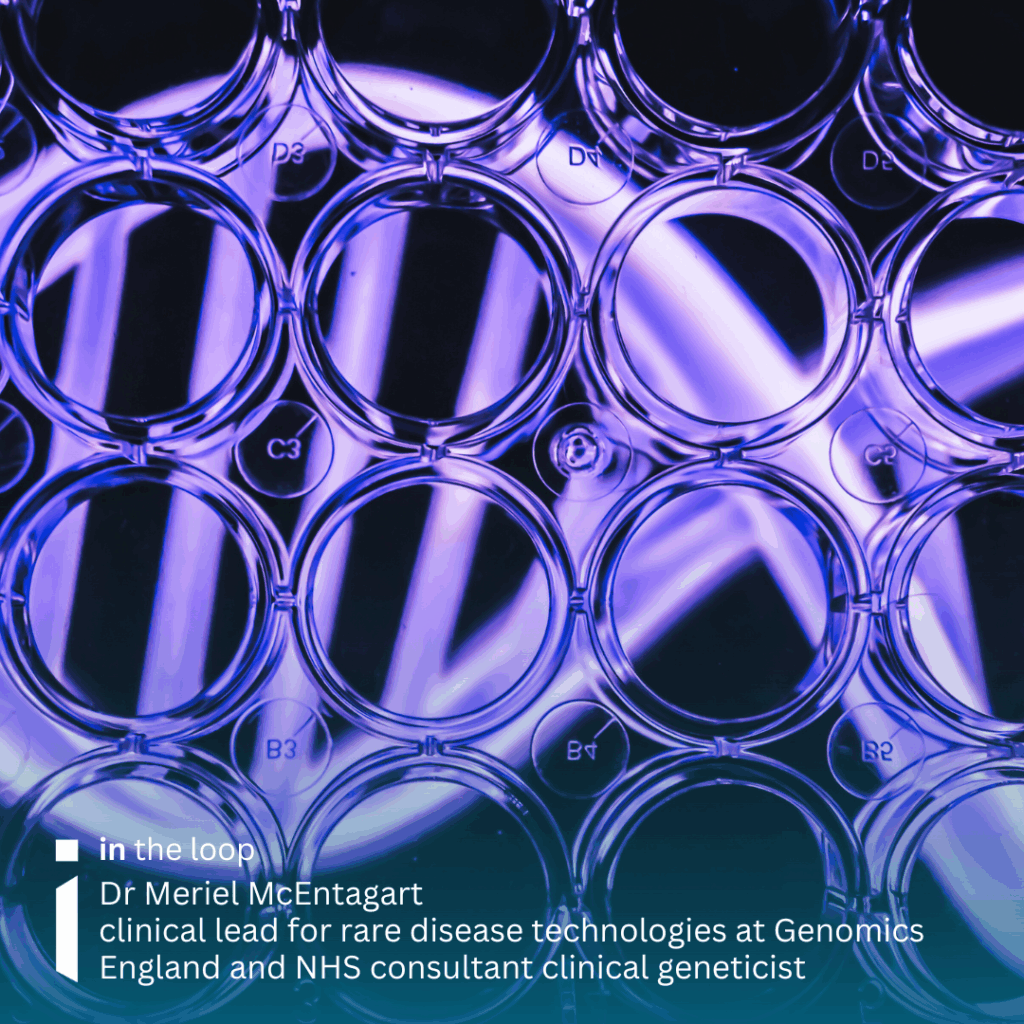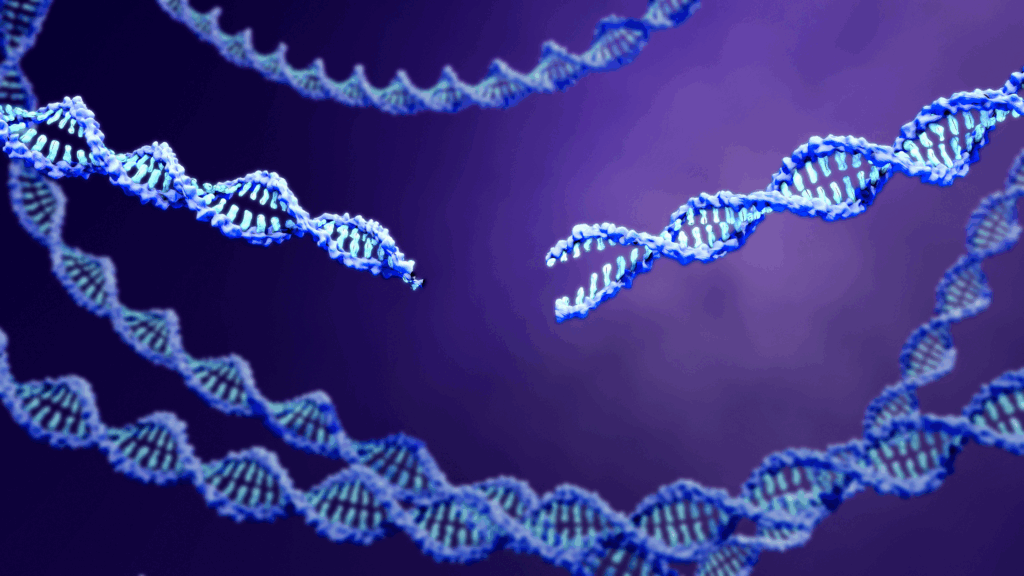Progress in delivering rare therapies
Estimated reading time: 0 minutes

Dr Meriel McEntagart, clinical lead for rare disease technologies at Genomics England and NHS consultant clinical geneticist, shared her perspective on progress in delivering rare therapies at this year’s Westminster Health Forum Policy Conference. Her presentation shows she remains optimistic that the next three to five years could see yet further accelerated pace
As science continues to advance, there is genuine hope that faster diagnosis and improved access to bespoke treatments for rare diseases may be possible in the near future.
While promising developments are in the pipeline, including in the UK, cautious optimism is still needed as Dr Meriel McEntagart discussed in her recent conference session.
Dr Meriel McEntagart is clinical lead for rare disease technologies at Genomics England and works in the NHS as a consultant clinical geneticist. She is also a member of the scientific board of the Myotubular Trust.
She began her Westminster Health Forum Policy Conference session by underlying the importance of getting a diagnosis for children and adults with rare disease. In good news, several advancements are already improving diagnosis in the UK.
Diagnostic improvements
“TheNational Genomics Test Directoryin England has really been a fantastic step forward in providing guidance and eligibility criteria for clinicians so they can learn what test to give for patients,” she explained.
“Whole genome sequencing is another diagnostic advancement as it’s not always possible for clinicians to suspect every type of condition. But whole genome sequencing helps to bring forward potential diagnoses that we haven’t heard of. It can also help when there is an unusual presentation of a condition that we do know of.”
Rapid testing pathways such as theR14 pathwayare also making a difference.
“R14 has been brilliant,” Dr McEntagart explained. “The Myotubular Trust have talked about how children used to wait a long time before they would have a diagnosis. But now we have the R14 rapid testing pathway, this means children in paediatric intensive care can get a diagnosis within around three weeks of being tested.”
Genomics England has a diagnostic delivery pathway and this is especially beneficial for people who don’t immediately have a diagnosis, she told the conference.
“When people have their whole genome sequencing done, there may not be a diagnosis at that stage. However, their data is constantly being reanalysed as we look at new gene discoveries, and new ways of interpreting short-read sequencing data. This will help to get more diagnoses out there. But, of course, one of the challenges of this is having the staff and the clinical scientists to be able to really push those turnaround times forward.”
Where change is needed
While there have been improvements in terms of diagnostics, changes to the system are overdue, Dr McEntagart explained.
“We need the system to be able to identify patients at the time of diagnosis who would benefit from an individualised therapy. So, we need a process where identification becomes automatic.
“Not all conditions are amenable to standard clinical trials with cases and controls. Added to this, many of these conditions are so rare that we need to have different ways of assessing the efficacy of individualised therapies for these conditions.”
Dr McEntagart also discussed the recent case of a little boy who has been successfully treated with a personalised CRISPR gene therapy.
“He has a very severe liver disease and this was apparent very quickly after he was born,” she explained. “Around 50% of children with this condition would die in infancy1, while others would need treatments to keep them alive, and to manage their dietary protein consumption to get them big enough to have a liver transplant. It’s a major challenge.”
In this little boy’s case, his condition was diagnosed very quickly and he was placed on treatments to try and manage the “toxic effects” of his condition.
“At the same time, scientists were working on developing this CRISPR therapy for him,” she continued. “This included identifying his specific mutations and designing a guide RNA molecule that would take the CRISPR therapy directly to his gene. The therapy would correct that spelling mistake in his gene so the gene could then start expressing the protein that is needed.”
The young patient received his first dose of his bespoke CRISPR therapy at seven months, and another at eight months. “Already, the effects of this treatment are taking effect as his liver has started to produce the protein that’s needed to manage his own diet. That really is very impressive,” Dr McEntagart told the conference.
“So, the science is really advancing, and where we are struggling is in developing that infrastructure and the systems and mechanisms to be able to deliver these therapies in reality.”

Bustling ecosystem
The rare diseases ecosystem is a bustling one with many organisations involved. But Dr McEntagart wanted to highlight three that each have bold ambitions to really make a difference in the field of genomic therapies.
N=1 Collaborativeis an international group of academic researchers, clinicians, industry stakeholders, patients and non-profit leaders. The organising committee includes scientific members including Dr Tim Yu (the designer of Mila’s bespoke treatment Milasen), and Mila’s mum, Julia Vitarello.
“Mila had a rare neurodegenerative condition and her mother worked really hard to find people who could help to make a diagnosis and develop a bespoke gene therapy for her daughter,” she explained. “The antisense oligonucleotide therapy was working in Mila’s cells by changing the gene message. But as her condition had advanced, it wasn’t able to cure it.
“Timing is really, really important in getting these diagnoses promptly before a condition has progressed so that if we can develop a therapy, it can be given time to make a difference.”
N=1 Collaborative has recently developed aconsensus guidelineon how to design nucleic acid therapies and how to assess eligibility for a gene therapy.
“At the moment, it’s focused on antisense oligonucleotide therapies but the aspiration stretches far beyond this. The idea is you would have a diagnosis on whole genome sequencing done rapidly, and at the same time that the genetic change is identified, this variant would go through an assessment process for eligibility for nucleic acid therapy.”
This would mean that when a clinician gets a report, they would already have the next steps. “It’s very aspirational but it’s promising,” she added.
TheUK Platform for Nucleic Acid Therapy(UPNAT) aims to further promote the development of NAT for rare diseases in the UK. They want to accelerate progress on this through three work packages. “The first is to work on a strategy for target selection to identify patients who may be eligible for a nucleic acid therapy,” Dr McEntagart explained. “This will also be looking at how these guidelines can be implemented in highly specialised NHS services.”
Work package two will look at tackling the challenge of having infrastructure in place that will enable these therapies to be synthesised and manufactured, while ensuring they are safe. The third work package will focus on translating this into clinical practice and it will also look at how nucleic acid therapies would be regulated in the UK.
Dr McEntagart was also eager to talk about the potential for real change that theRare Therapies Launch Pad(RTLP) hopes to introduce. The RTLP is a pilot programme for individualised medicines in the UK and it’s about to undertake an ambitious test study.
“They want to work through the creating and delivering an individualised therapy pathway to really understand what infrastructure is needed to make this a reality,” she explained. “They’re hoping to select a small number of children with very rare and progressive neurodegenerative conditions and design antisense oligonucleotide therapies for them as part of the test pilot study.
“One of their main goals is to have a new pathway worked out end-to-end and to really examine policy, regulation and legislation to identify any gaps that might need to be addressed,” she continued. “They will also look at existing precedents for other rare conditions where there have been compassionate therapies developed.”
Audience questions
Following on from this strand of Dr McEntagart’s conference session, an audience member asked for her views on how far away the UK is from being able to offer individualised therapies.
“I think within the next three to five years, we will really see the pace pick up,” she said in response. “We have a lot of clinical scientific expertise here and there’s a lot of willingness. There is a real will for the UK to deliver this. Maybe I’m over optimistic, but it’s the ambition of the RTLP to really test out and improve the process. They want to have carried out the test study (and created personalised therapies) for those patients in that kind of timeline.”
Another question is asked around the important role of families and whether research initiatives (such as when patients take part in clinical trials) involve the family and carer voice enough.
“We’re getting better at it,” Dr McEntagart responded. “I think all observations need to be sought to capture any information that families have. If we’re able to gather insights from family members that can help give us a better understanding, we could spot signals that we may not have noticed otherwise.
“Listening to families and having better ways to empower them to be able to contribute their knowledge and understanding about their child’s particular condition is important,” she added.
Connect with Genomics England
References
[1] https://www.nejm.org/doi/full/10.1056/NEJMoa2504747
in the loop lets you stay informed with all the latest issues from the world of RARE. To access more in the loop articles click below.

